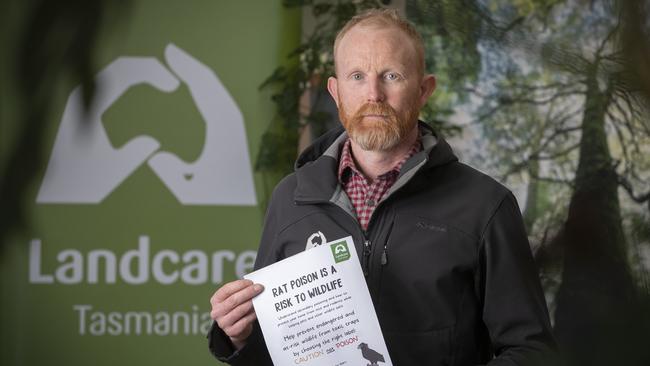Single-dose rat poison killing Tassie’s native wildlife, including wedge-tail eagles
The convenience of buying single dose rat poison from supermarket shelves is killing native wildlife in Tasmania including wedge-tail eagles and frogmouth owls. THE DANGERS >>

News
Don't miss out on the headlines from News. Followed categories will be added to My News.
The convenience of buying single dose rat poison from supermarket shelves is killing native wildlife in Tasmania including wedge-tail eagles and frogmouth owls.
Rodents are making their way inside into homes as temperatures get colder and people are using poisonous single dose rat kill as their primary defence, according to experts.
Raptor specialist Nick Mooney said the most dangerous rat poison is the single dose bait which is the most popular one on store shelves.

“The second generation anticoagulants are the most dangerous ones … just through pure convenience people love these single doses,” he said.
“The ingredients for those are not biodegradable and they’re very powerful, but they’re not immediate so the rat won’t die straight away.
“Let’s say a rat ate some bait, it will eat much more than it needs to kill it because it’ll take a couple of hours to die and they stagger around and often die in open places where they can be scavenged by anything.
“If a raven eats a (poisoned) dead rat it will die, and then a wedge tail eagle might eat the raven, so it gets several doses that way, it accumulates the higher up the food chain.”
He said there needs to be more regulation because the community continues to use these lethal baits in large quantities.
“The regulation is pretty sloppy … because of traditional use of chemicals in Australia, we just let people buy stuff that you can’t easily buy in other countries,” he said.
“Lots of hawks and owls around the city – frogmouths, butcherbirds, magpies, lots of these animals get killed through the city in winter, simply because there’s a lot of rat poison going on.
“Some of these poisons are used on an agricultural scale so they’re way out there out all around us in the landscape.”
Mr Mooney said the primary defence against rodents is properly securing buildings, keeping a clean space and properly storing food away.
“It’s not rocket science. Leaving rubbish lying around is an invitation for rats, poorly controlled compost heaps … but people are lazy,” he said.

Landcare Tasmania chief executive Peter Stronach said single dose poisons are “vicious” and detrimental to the ecology of the food web.
“It’s great to do revegetation, but if everything’s dead, we lose all our top predators. Our apex predators are crucial to us having functioning ecosystems,” he said.
He said species like the wedge-tail eagle are getting a secondary dose of rat poison through what they eat.
“They’re eating things like reptiles,” Mr Stronach said.
“A lizard (that eats a poisoned dead rat or mouse) is very different in the way that they assimilate the chemical. They don’t necessarily die but become very toxic.”
Because a lizard becomes toxic after eating a poisoned rat, they pass it on to the species that predates on them like a wedge-tail eagle which then kills them.
Pied Piper Pest Control owner and technician AJ Whitehead said people need to use rat poison carefully and stay away from the second generation.
“People don’t realise how dangerous these poisons are to any animal, any living thing, really,” he said.
To help prevent endangering and at-risk wildlife from toxic traps, consumers are urged to choose the caution label over the poison label. For more information, visit Landcare Tasmania.
More Coverage
Originally published as Single-dose rat poison killing Tassie’s native wildlife, including wedge-tail eagles




